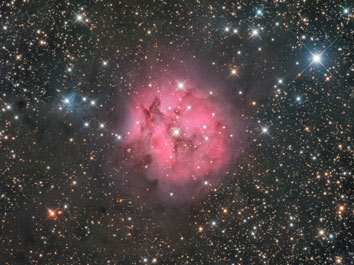Create a free profile to get unlimited access to exclusive videos, sweepstakes, and more!
An Ionized Flower Blooms in Space

Oh, do I love me some young stars throwing their weight around! Behold what happens when they do:
This photo was taken by “amateur” astronomer Kerry-Ann Lecky Hepburn, using a 20 cm Astro-Tech RC telescope, and is a total of nearly nine hours of exposure through various filters.
What it shows is the famed Cocoon Nebula, also called IC 5146. What you’re seeing is actually a cluster of young stars called Collinder 470, which is roughly 2,500 light-years away. And I do mean young; the bright star in the center of the nebula is only about 100,000 years old. Compare that to the Sun’s 4,560,000,000 years, and you’ll understand why these stars are mere whippersnappers.*
Stars form from clouds of gas and dust, and there are both in plenty here. The dark dust is strewn everywhere in this picture; you can see it as gray or black diffuse clouds. Note that where it lies, swaths of stars appear red; dust scatters away or absorbs blue light, letting only red light through. Most of the stars you see glowing ruddily in the dust are literally in that dust, or behind it.
But the bloom of the rose in this photo is obviously the bright pink nebula itself. The star in the center, called BD+46°3474, is a hot, massive B-type star. It’s a beast, five times the diameter of the Sun, 15 times its mass, and a brutal 20,000 times as luminous. Replace the Sun with BD+46 and the Earth would be a smoking ruin.
The power of a star like this can profoundly affect its environment. In this case, the star is embedded in a molecular cloud, a huge, dense clump of cold material—in this case, several hundred times the mass of the Sun worth of material. BD+46 was near the edge of the cloud, and when the star was born, its fierce light and energy inflated the cloud, created a blister in the side, and then blew it out entirely. What’s left is a cavity carved out of the side of the dense cloud filled with much lower density gas. The hydrogen gas inside the cavity glows characteristically red/pink, lit up literally like a neon sign.
At first I thought this might be a Strömgren sphere: a lone gas cloud in space lit by a star within. The edge of such a sphere is defined by where the starlight gets too weak to make the gas glow. But those tend to have sharper edges than what we see here, and clearly the Cocoon has fuzzy edges. That implies the gas is interacting with denser material, which is what you expect from a blowout in the side of the cloud. In this sense, it’s much like the Orion Nebula, though on a somewhat smaller scale.
Gorgeous, isn’t it? If you like it, you should check out more of Hepburn’s work. She’s quite gifted and has an amazing array of photos on her site.
*Get off my galaxy! <shakes fist>


























